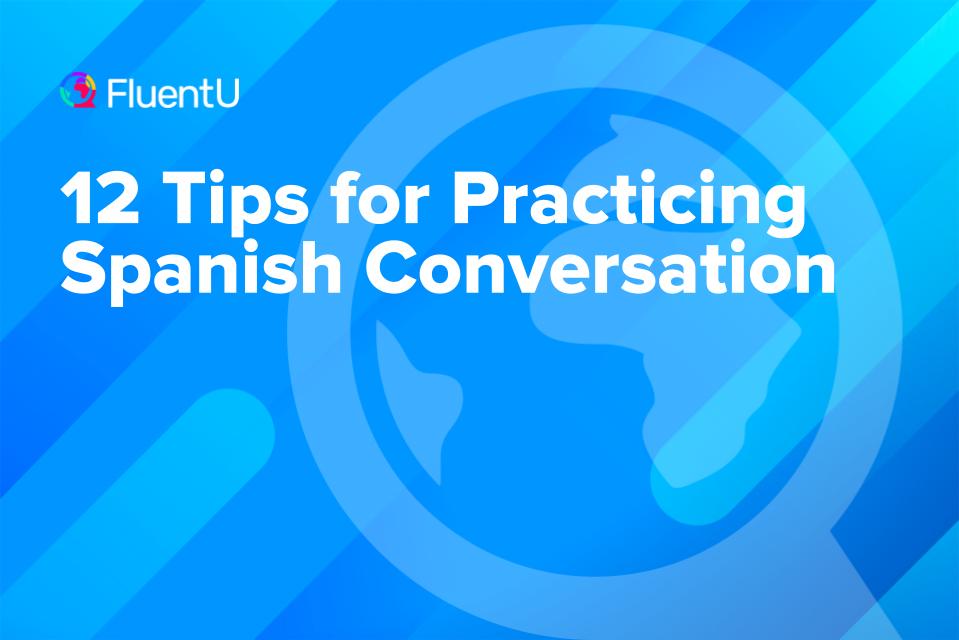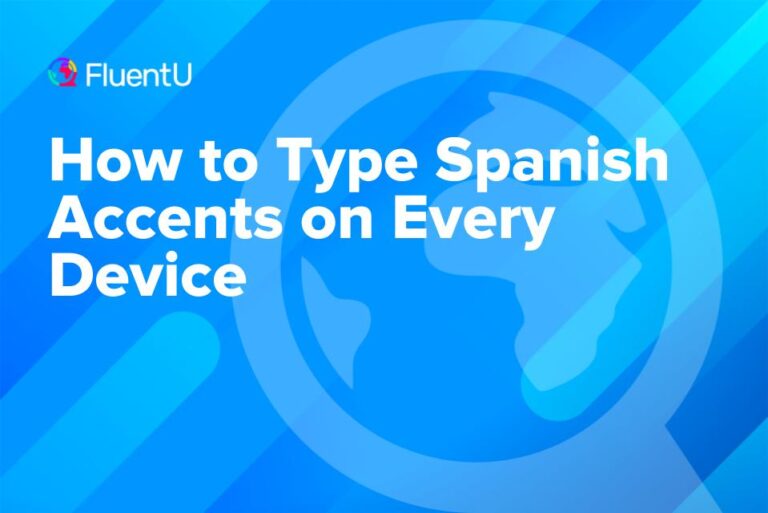Contents
- 1. Learn the Right Vocabulary and Phrases
- 2. Practice at Least 2-3 Times Per Week
- 3. Find a Variety of People to Talk With
- 4. Expand Your Skills by Signing Up for Group Conversations
- 5. Invest in a Little Pre-conversation Preparation
- 6. Turn Note-taking into a Habit
- 7. Find the Balance Between Questions and Answers
- 8. Record Your Conversations
- 9. Practice Spanish Conversation Without a Partner
- 10. Try Shadowing
- 11. Take an Online Spanish Speaking Course
- 12. Keep the Focus on Fluidity and Pronunciation
- And One More Thing…
12 Tips for Practicing Spanish Conversation

Have you found a Spanish conversation partner in town? Are you chatting with someone online from the comfort of your own home? Or maybe you’re still a bit hesitant about talking to a native speaker and haven’t set something up yet.
To get the most out of conversation classes or exchanges—whether you’re a beginner or advanced speaker—I have put together 12 fantastic tips (that I’ve used myself) to make the most of your Spanish conversation practice.
Download: This blog post is available as a convenient and portable PDF that you can take anywhere. Click here to get a copy. (Download)
1. Learn the Right Vocabulary and Phrases
Practice makes perfect, but you can’t practice Spanish conversation without learning some words first.
If your focus is on being conversational, you don’t have to learn the whole Spanish dictionary. Instead, you can focus your vocabulary learning on phrases and words you’ll use often in conversation. Then, you can gradually work your way up to more challenging and meaningful conversations.
There are tons of resources on Spanish for beginners that can help you build up your Spanish vocabulary. Choose material and sources that are compatible with you and your way of learning, and try to always use your new vocab during your conversation practice sessions.
This sentence-building lesson from our YouTube channel is a great place to start:
Read on to find some useful phrases and sentences for everyday conversations.
Getting to know each other
- ¿Cómo te llamas? (What’s your name? Lit. How are you called?)
- ¿De dónde eres? (Where are you from?)
- ¿Dónde naciste? (Where were you born?)
- ¿De dónde es tu familia? (Where’s your family from?)
- ¿Has estado alguna vez en…? (Have you ever been to…?)
- ¿Desde cuándo vives aquí? (How long have you been living here?)
- ¿Hablas algún idioma aparte de español? (Do you speak any other language beside Spanish?)
- ¿Cuál fue el último país que visitaste? (What’s the last country you visited?)
- ¿Tienes hermanos o hermanas? (Do you have any brothers or sisters?)
- ¿Tienes perro o gato? (Do you have a dog or cat?)
- ¿Conoces a…? (Do you know…?)
Hobbies and interests
- ¿Qué te gusta hacer en tu tiempo libre? (What do you like to do in your free time?)
- Me encanta / Me encantan… (I love [singular/plural].)
- No me gusta / No me gustan… (I don’t like [singular/plural].)
- Detesto / Odio… (I detest/I hate…)
- ¿Te gusta [name of the city or country]? (Do you like [name of city or country]?)
- ¿Te gustan los libros de [author]? (Do you like [author]’s books?)
- ¿Cuál es el último libro que has leído? (What’s the last book you read?)
- ¿Has visto alguna película de [actor/director]? (Have you watched any [actor/director] movie?)
- ¿Cuál es la última película que has visto? (What’s the last movie you watched?)
- Me gustan las películas de [genre]. (I like [genre] movies.)
- ¿Qué tipo de música te gusta? (What kind of music do you like?)
- Me gusta…
(I like…)
…el pop. (…pop.)
…el rock. (…rock.)
…la música clásica. (…classical music.)
…la salsa. (…salsa.)
…el jazz. (…jazz.) - ¿Tienes algún pasatiempo? (Do you have any hobbies?)
- ¿Cuál es tu pasatiempo favorito? (What’s your favorite hobby?)
- ¿Qué te gusta hacer en tu tiempo libre? (What do you like to do in your free time?)
- ¿Cuál es tu deporte favorito? (What’s your favorite sport?)
- ¿Practicas algún deporte? (Do you play any sports?)
- ¿Juegas al…
(Do you play…)
…fútbol? (…soccer?)
…baloncesto? (…basketball?)
…tenis? (…tennis?)
…vóleibol? (…volleyball?)
…ajedrez? (…chess?) - ¿Vas mucho a la playa? (Do you go to the beach often?)
- ¿Te gusta el verano? (Do you like summer?)
The weather
- ¡Qué día tan…
(What a…)
…lluvioso! (…rainy day!)
…caluroso! (…hot day!)
…frío! (…cold day!)
…bueno! (…nice/good day!)
…malo! (…bad day!)
…ventoso! (…windy day!) - Parece que va a llover. (It looks like it’s going to rain.)
School and work
- ¿En qué trabajas? / ¿A qué te dedicas? (What’s your job?/What do you do for a living?)
- Soy…
(I’m…)
…enfermera. (…a nurse.)
…camarera. (…a waitress.)
…profesor de idiomas. (…a language teacher). - Me dedico a…
(I…)
…cuidar enfermos. (…take care of sick people.)
…la hostelería. (…work in hospitality.)
…enseñar idiomas. (…teach languages.) - ¿Qué estudias? (What do you study?/What are you studying?)
- ¿Vas a la universidad? (Do you go to college/university?)
- ¿Cuál es tu especialidad? (What’s your major/specialty?)
Saying goodbye
- Nos vemos pronto. (See you soon.)
- Encantado de conocerte. (Nice to meet you.)
- Me ha gustado mucho hablar contigo. (It’s been nice talking to you.)
- Ha sido un placer conocerte. (It’s been a pleasure to meet you.)
- Hasta la vista. (So long.)
How to put this tip into practice:
- Learn some Spanish small talk. Every situation is the perfect situation to practice your Spanish conversation skills, so arm yourself with small talk ammunition and you’ll always be ready to talk.
- Learn Spanish core vocabulary. Core words are a language’s most often used words. Their so common because they can adapt to different contexts, i.e. they have different meanings and uses. By learning the most common Spanish words, you’ll be able to understand and say much more by using fewer words.
- Learn Spanish cognates. Cognates are words that look identical or very similar in two or more languages. Additionally, they have the same meaning across those languages, so they’re basically words you’ll be able to learn in the blink of an eye. Adding Spanish cognates to your word bank is one of the easiest ways to improve your Spanish vocabulary, which will allow you to have more and better conversations with native Spanish speakers.
2. Practice at Least 2-3 Times Per Week
I found that conversation classes once a week really weren’t enough for me. The only real way to become fluent in Spanish is to speak as frequently as possible.
Twice a week is a really good start, but three times a week is ideal. You don’t have to have long sessions—even 30 minutes three times a week can make a real difference.
It’s also absolutely vital that you learn how to speak Spanish with a native speaker. It doesn’t matter if he or she has teaching experience or knows how to explain Spanish grammar to you. What’s important is that you hear natural speech from a native speaker.
How to put this tip into practice:
- Be consistent. If you practice your speaking skills a few times a week, you’ll be consistently feeding your brain with Spanish vocabulary and grammar structures. The result will be a faster and improved mastery of the language.
- Don’t overdo it. It’s fine to practice conversation for an hour if you’re feeling motivated, but avoid long study sessions of several hours if you really want to absorb what you’re learning. Microlearning has been proved to be very beneficial, especially for language learners. Take advantage of it!
3. Find a Variety of People to Talk With
I took conversation classes for about six months while living in Venezuela and for about two years while living in Argentina. I made sure that I had sessions organized with more than one person in both countries. I found the variety to be really important.
I learned street slang from some and formal speech and an extensive vocabulary from others. With some, we talked about our personal lives, with others, we gossiped and talked about cinema and art exhibitions.
Whether I’m in an interview, traveling across the rural plains of Latin America, chatting with friends on a Friday night after work or discussing the importance of arts and culture, I now have access to the appropriate vocabulary and can express my views through words that fit the social context. I wouldn’t be able to do this without having enjoyed such varied conversations with such different people during these conversation classes.
How to put this tip into practice:
- Find a Spanish language exchange partner. Find a native Spanish person who’s learning your mother tongue and meet with them often to practice your conversation skills.
- Find an online Spanish language exchange. If you want to practice speaking without leaving your house, look for conversation partners online. Here are our top apps for language exchange:
4. Expand Your Skills by Signing Up for Group Conversations
I strongly recommend organizing a combination of both private conversation classes and group sessions. The key is to find a group of language learners who have a better level of Spanish than you.
Group sessions are also useful because they force you to speak Spanish while listening to a number of people talking at the same time. This prepares you for real-life social situations in Spanish, and there’s nothing better than sessions that equip you with skills you’ll actually end up using.
How to put this tip into practice:
- Join the Mundo Lingo Telegram group. Find people from your city or from all around the world. Participate in the Live Rooms conversations and attend the weekly social meetings if they happen to take place in your city.
- Search for Spanish conversation groups on Meetup. There are over four thousand members from all around the world!
5. Invest in a Little Pre-conversation Preparation
If your level of Spanish is anything between beginner to intermediate, it’s a good idea to read or watch something in Spanish before turning up to your conversation class—in order to have something to talk about.
When first starting out, the most difficult thing about a conversation class is having the vocabulary to be able to keep the dialogue moving. By watching or reading something specific beforehand, you’ll arrive to your conversation class with a bank of vocabulary to draw upon and a topic in mind.
I also used to send what I’d read or watched to my conversation buddy before attending the session. It noticeably helped when the other person knew what I’d seen or read. They were able to help me by directing the conversation whenever I found that I was unable to express myself in Spanish.
How to put this tip into practice:
- Decide on one or two conversation topics. Before your conversation session, pick a couple of topics you want to talk about. Watch a video or read an article about the topic to prepare. Make sure to write down any relevant vocabulary so you don’t get stuck trying to come up with the right words.
- If you’re having a hard time deciding what to talk about, you can always look for inspiration and conversation topics online.
- Use FluentU to boost your listening and speaking skills.
FluentU takes authentic videos—like music videos, movie trailers, news and inspiring talks—and turns them into personalized language learning lessons.
You can try FluentU for free for 2 weeks. Check out the website or download the iOS app or Android app.
Click here to take advantage of our current sale! (Expires at the end of this month.)

6. Turn Note-taking into a Habit
Get into the habit of taking a small notebook to the conversation sessions with you. Write down all new words that crop up during the class and re-read your notes throughout the week. This will help you familiarize yourself with the vocabulary and employ it more often.
I still re-read my old notebooks every now and then, and I still come across words that I’d heard in conversation but very rarely employ when I speak. The learning never stops!
How to put this tip into practice:
- Learn how to take language learning notes. Depending on the type of learner you are, taking notes might take different forms. Find the one that’s best for you!
- Learn how to organize a foreign language notebook. The art of keeping a language notebook isn’t easy, but once you learn some tricks, taking notes will be your favorite part of the learning process.
7. Find the Balance Between Questions and Answers
Take it in turns to be the one who asks the questions and the one who responds when participating in conversation practice. Some native speakers enjoy asking lots of questions and others are more content to sit back and have you guide the class.
The problem is that you need to ensure you get the chance to practice asking questions and answering them. You need to have the chance to improve both kinds of grammar constructions, so keep an eye out.
If you feel that you’re always asking questions, make it clear to your conversation buddy that you’d really benefit from responding to questions during the sessions too.
How to put this tip into practice:
- Learn how to ask questions. You want to make the most out of your conversation sessions, so learn how to build questions before actually asking them. That’ll save you precious time that can be used for listening to your native speaker answer your queries.
- Practice answering questions in complete sentences and do it during your conversation classes, too. Giving answers in complete sentences will help you speak faster and more fluently in the long run, even if it seems harder at the beginning.
8. Record Your Conversations
If your conversation partner doesn’t object, one of the best things you can do to get the most out of your conversation classes is to record each session.
Once the class is through, you can listen to the conversation over and over again. I used to use these recordings to reinforce what I’d learned during the session and to correct my pronunciation.
Hearing myself in the recordings helped me notice the incorrect vowel tones I was making. I was able to hear how the natives spoke certain words and how I spoke them.
How to put this tip into practice:
- Make the most out of your recordings. Don’t just listen to the recordings after your conversation sessions. Write down the words you mispronounced, make flashcards with the new words you learned from your partner, read about grammar constructions you got wrong… Work with the audio and transform it into an additional language lesson!
- Record yourself while reading out loud. You don’t need to be having a conversation to record yourself. Grab an easy Spanish book and read a fragment out loud. Record yourself and then use the audio to work on improving your pronunciation, intonation and rhythm.
9. Practice Spanish Conversation Without a Partner
Yup, you’ve read that right. You can also practice Spanish conversation without a partner.
Granted, conversations with a native speaker are going to help you much more than practicing on your own, but if for some reason you have to survive without a partner for now, there are several tricks and techniques you can use to keep improving your Spanish conversation skills.
How to put this tip into practice:
- Think in Spanish and talk to yourself. Make yourself think in Spanish as often as you can throughout the day. You don’t need to be doing anything special to decide to switch to Spanish.
If you’re trying to remember what you need to get from the grocery store, do it in Spanish. Are you cooking? Tell yourself what you’re doing in Spanish. Going for a walk? Describe what you see in Spanish. Every opportunity to think or talk to yourself in Spanish is golden.
- Pretend you’re a different person. Sit in front of the mirror and pretend you’re having a conversation with a stranger. Ask them how to get to the nearest museum, the price of gas or the latest discovery in science. Then, answer the question in Spanish in a way that they (you) can definitely understand.
- Use tongue twisters. Tongue twisters will help you conquer the most difficult sound combinations in Spanish. After that, normal conversations will be completely unchallenging for you.
10. Try Shadowing
Simply put, language shadowing is a learning technique in which you listen to some audio in your target language and repeat it several times while trying to imitate the accent, pronunciation, rhythm and intonation of the native speaker.
Language shadowing doesn’t actually focus on understanding the language. In fact, at the beginning you’ll be shadowing words, phrases and sentences you probably won’t understand. However, this language learning technique was created in a way that allows you to pick up vocabulary and grammar constructions as you go.
Since the main focus is on the repetition of native audio, you can use any native Spanish media you may have available. Shadowing is best used when learning by yourself, but if your language partner is OK with you turning into a Spanish-speaking parrot, bring him into your Spanish shadowing sessions!
How to put this tip into practice:
- Choose a Spanish podcast on a topic you like. If you’re familiar with the topic in your native language and you enjoy it, it’ll be easier for you to start learning new words and grammar rules you can later use in real Spanish conversations.
- Use native Spanish media. If you have Netflix or access to any Spanish TV show or program, you can practice Spanish language shadowing and pretend you’re a news reporter, your favorite Spanish actor or even the weatherman. Just have fun!
- Read the translation and the transcript after your shadowing session. After finishing your shadowing session, you can listen to the audio a couple of times while you read the translation and the transcript/subtitles of the audio (if available). This will help you understand and consolidate what you’ve been repeating and memorizing during the session.
11. Take an Online Spanish Speaking Course
When it comes to practicing conversation, not many learners take online speaking courses into consideration, and that’s a pity.
Online speaking courses are a great way to improve this skill when you’re too busy to meet your language partner or you need an official certificate.
Besides, online speaking courses are normally flexible yet well-structured, and they’re the perfect kind of practice before you put yourself out there and start talking to native Spanish speakers.
How to put this tip into practice:
- Take the “Conversational Spanish Made Easy” course on Udemy. If you’re a beginner and want to start speaking Spanish now, this is the course for you.
- Take OfCourse’s “Master a Skill Bundle: Conversational Spanish” course. Actually, these are three courses for the price of one. They include 196 lectures for beginners and intermediate learners.
12. Keep the Focus on Fluidity and Pronunciation
Finally, to get the most out of the conversation sessions, it’s important to recognize that these classes are meant to improve fluidity and pronunciation.
They’re not designed for grammar practice or for correcting poorly constructed sentences. You must make sure that you stay focused during these sessions, and that you don’t waste valuable time asking your conversation buddy to help you conjugate in the past tense, for example.
How to put this tip into practice:
- Make a note of grammar doubts in a notebook during the conversation classes. Later on, go back to your notes and find the answer to your grammar questions through another route. Your time with native speakers is golden, and it isn’t to be wasted on a series of grammar questions that you can work out for yourself at a later date.
- Remember: Think less, speak more, ignore your mistakes and keep talking with a smile. Conversation classes are all about fluidity, so avoid stopping in the middle of every sentence to make corrections.
Just go with the flow, and your Spanish conversation practice will pay off when it’s time to put them into practice.
Download: This blog post is available as a convenient and portable PDF that you can take anywhere. Click here to get a copy. (Download)
And One More Thing…
If you've made it this far that means you probably enjoy learning Spanish with engaging material and will then love FluentU.
Other sites use scripted content. FluentU uses a natural approach that helps you ease into the Spanish language and culture over time. You’ll learn Spanish as it’s actually spoken by real people.
FluentU has a wide variety of videos, as you can see here:

FluentU brings native videos within reach with interactive transcripts. You can tap on any word to look it up instantly. Every definition has examples that have been written to help you understand how the word is used. If you see an interesting word you don’t know, you can add it to a vocab list.

Review a complete interactive transcript under the Dialogue tab, and find words and phrases listed under Vocab.

Learn all the vocabulary in any video with FluentU’s robust learning engine. Swipe left or right to see more examples of the word you’re on.

The best part is that FluentU keeps track of the vocabulary that you’re learning, and gives you extra practice with difficult words. It'll even remind you when it’s time to review what you’ve learned. Every learner has a truly personalized experience, even if they’re learning with the same video.
Start using the FluentU website on your computer or tablet or, better yet, download the FluentU app from the iTunes or Google Play store. Click here to take advantage of our current sale! (Expires at the end of this month.)

















